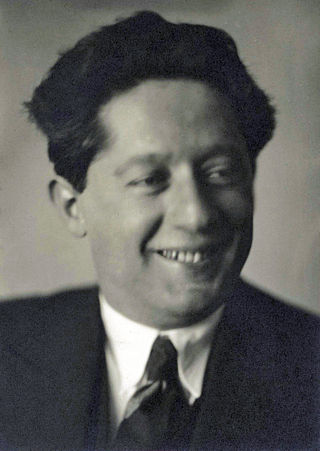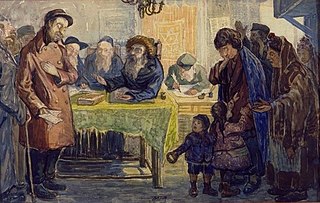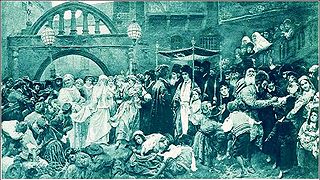
Marriage in Judaism is the documentation of a contract between a Jewish man and a Jewish woman in which God is involved. In Judaism, a marriage can end either because of a divorce document given by the man to his wife, or by the death of either party. Certain details, primarily as protections for the wife, were added in Talmudic times.

Women in Judaism have affected the course of Judaism over millenia. Their role is reflected in the Hebrew Bible, the Oral Law, by custom, and by cultural factors. Although the Hebrew Bible and rabbinic literature present various female role models, religious law treats women in specific ways. According to a 2017 study by the Pew Research Center, women account for 52% of the worldwide Jewish population.
The relationships between the various denominations of Judaism are complex and include a range of trends from the conciliatory and welcoming to hostile and antagonistic.

Joseph Ber Soloveitchik was a major American Orthodox rabbi, Talmudist, and modern Jewish philosopher. He was a scion of the Lithuanian Jewish Soloveitchik rabbinic dynasty.

Saul Lieberman, also known as Rabbi Shaul Lieberman or, among some of his students, the Gra"sh, was a rabbi and a Talmudic scholar. He served as Professor of Talmud at the Jewish Theological Seminary of America (JTSA) for over 40 years, and for many years was dean of the Harry Fischel Institute in Israel and also president of the American Academy for Jewish Research.

A ketubah is a Jewish marriage contract. It is considered an integral part of a traditional Jewish marriage, and outlines the rights and responsibilities of the groom, in relation to the bride. In modern practice, the ketubah has no agreed monetary value, and is seldom enforced by civil courts, except in Israel.
An agunah is a Jewish woman who is stuck in her religious marriage as determined by halakha. The classic case of this is a man who has left on a journey and has not returned, or has gone into battle and is missing in action. It is used as a borrowed term to refer to a woman whose husband refuses, or is unable, to grant her a divorce.
Legal responses to agunah are civil legal remedies against a spouse who refuses to cooperate in the process of granting or receiving a Jewish legal divorce or "get".

A get, ghet, or gett is a document in Jewish religious law which effectuates a divorce between a Jewish couple. The term is also used to refer to the divorce itself. The get is a 12-line document written in Aramaic. The requirements for a get include that the document be presented by a husband to his wife. The essential part of the get is a very short declaration: "You are hereby permitted to all men". The effect of the get is to free the woman from the marriage, and consequently she is free to marry another and that the laws of adultery no longer apply. The get also returns to the wife the legal rights that a husband held in regard to her.
Jewish feminism is a movement that seeks to make the religious, legal, and social status of Jewish women equal to that of Jewish men in Judaism. Feminist movements, with varying approaches and successes, have opened up within all major branches of the Jewish religion.

A Jewish wedding is a wedding ceremony that follows Jewish laws and traditions. While wedding ceremonies vary, common features of a Jewish wedding include a ketubah which is signed by two witnesses, a chuppah or huppah, a ring owned by the groom that is given to the bride under the canopy, and the breaking of a glass.
Howard (Chaim) Jachter is an American Orthodox rabbi, Dayan, educator, and author. He sits on the Beth Din of Elizabeth, New Jersey as a Dayan and Get administrator. Noted as an expert on the laws of Jewish divorce, he also chairs the Agunah Prevention and Resolution Committee of the Rabbinical Council of America. Rabbi Jachter is also the consulting rabbi for over 60 Eruvs across the United States. He serves as the Rabbi of Sha'arei Orah, the Sephardic Congregation of Teaneck, and is a faculty member at the Torah Academy of Bergen County (TABC). Author of sixteen books and over one thousand online and journal articles, he writes and lectures extensively on contemporary topics in Jewish law and thought. He has five children.
Conservative Judaism views halakha as normative and binding. The Conservative movement applies Jewish law to the full range of Jewish beliefs and practices, including thrice-daily prayer, Shabbat and holidays, marital relations and family purity, conversion, dietary laws (kashrut), and Jewish medical ethics. Institutionally, the Conservative movement rules on Jewish law both through centralized decisions, primarily by the Rabbinical Assembly and its Committee on Jewish Law and Standards, and through congregational rabbis at the local level. Conservative authorities produced voluminous Responsa literature.

HaRav Mordechai Yitzchak HaLevi Willig is an Orthodox rabbi and rosh yeshiva at Yeshiva University in Washington Heights, Manhattan. He is often known to his students as the Ramu, which is the transliteration of the acronym of the Hebrew letters Reish, Mem, and Vav, which spell out the first letters of Willig's title and name.
Michael Jay Broyde is a professor of law and the academic director of the Law and Religion Program at Emory University School of Law. He is also a senior fellow in the Center for the Study of Law and Religion at Emory University. His primary areas of interest are law and religion, Jewish law and Jewish ethics, and comparative religious law. Broyde has published 200 articles on various aspects of law and religion and Jewish law, and a number of articles in the area of federal courts.
The Jewish prenuptial agreement has been developed in recent times with the stated intent of keeping the Jewish woman from becoming an agunah in cases where the husband refuses to grant her a get. Without such an agreement, Jewish marriages cannot be dissolved without the consent and cooperation of both spouses. This new type of prenuptial agreement makes provisions for the possibility of divorce. By setting up rules prior to the marriage in the form of a contract, both spouses have an interest to negotiate a divorce in a dignified manner, and get-refusal is avoided.
Orthodox Jewish feminism is a movement in Orthodox Judaism which seeks to further the cause of a more egalitarian approach to Jewish practice within the bounds of Jewish Law. The major organizations of this movement is the Jewish Orthodox Feminist Alliance (JOFA) in North America, and Women of the Wall (WOW) and its affiliates in Israel and internationally, known as The International Committee for Women of the Wall (ICWOW). In Israel, the leading Orthodox feminist organization is Kolech, founded by Dr. Chana Kehat. In Australia, there is one Orthodox partnership minyan, Shira Hadasha, in Melbourne.
A bat-kohen or bat kohen is the daughter of a kohen, who holds a special status in the Hebrew Bible and rabbinical texts. She is entitled to a number of rights and is encouraged to abide by specified requirements, for example, entitlement to consume some of the priestly gifts, and an increased value for her ketubah.
The New York divorce coercion gang was a Haredi Jewish group who kidnapped, and in some cases tortured, Jewish men in the New York metropolitan area to force them to grant their wives religious divorces (gittin). The Federal Bureau of Investigation (FBI) broke up the group after conducting a sting operation against the gang in October 2013. The sting resulted in the prosecution of four men, three of whom were convicted in late 2015.
The Melbourne Beth Din (MBD) is an Orthodox / Chassidic Jewish court in the city of Melbourne, Australia. Located in Caulfield North, Victoria, it rules mostly on divorces and conversions although it does rule on other matters as well.








